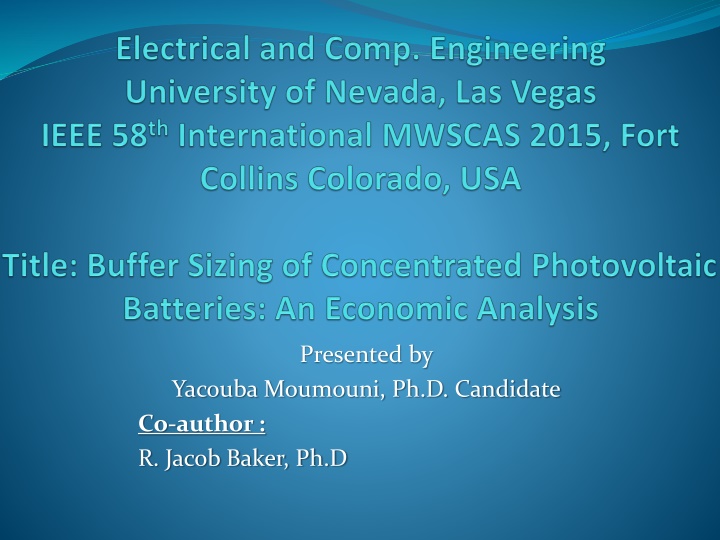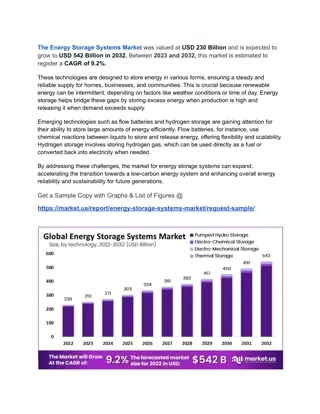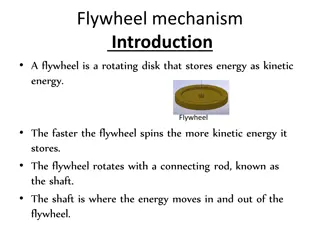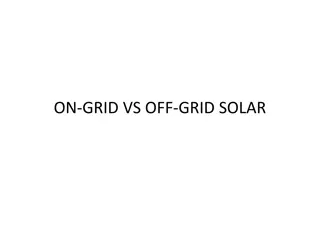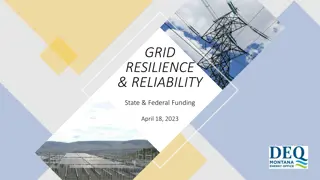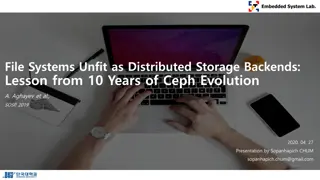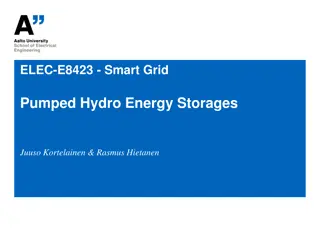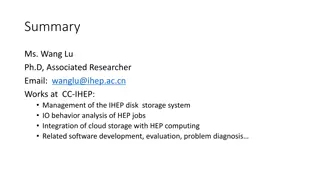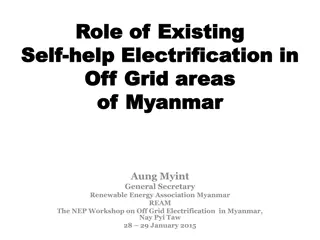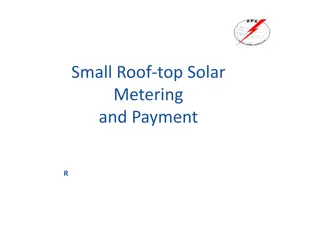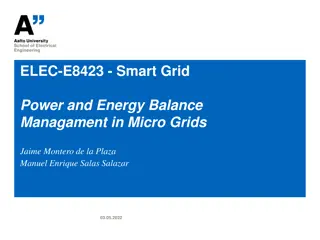Economic Performance of Grid-Tied Energy Storage Systems
Investigating battery-sizing techniques, parameter calculations, and cost estimation for grid-tied energy storage systems. Discussion on shifting off-peak power to on-peak, using second-life EV batteries, and cost effectiveness. Addressing the importance of energy storage in renewable energy applications.
Download Presentation

Please find below an Image/Link to download the presentation.
The content on the website is provided AS IS for your information and personal use only. It may not be sold, licensed, or shared on other websites without obtaining consent from the author.If you encounter any issues during the download, it is possible that the publisher has removed the file from their server.
You are allowed to download the files provided on this website for personal or commercial use, subject to the condition that they are used lawfully. All files are the property of their respective owners.
The content on the website is provided AS IS for your information and personal use only. It may not be sold, licensed, or shared on other websites without obtaining consent from the author.
E N D
Presentation Transcript
Presented by Yacouba Moumouni, Ph.D. Candidate Co-author : R. Jacob Baker, Ph.D
Contents 1. Abstract 2. Introduction 3. BATTERY BASIC PRINCIPLES 4. BATTERY PARAMETERS CALCULATION 5. CHARGING AND DISCHARGING ANALYSIS 6. Economic analysis 7. Conclusion 8. References Questions and Answers 3/6/2025 IEEE 58th Int. MWSCAS 2015, Fort Collins, CO 2
1. Abstract Energy storage systems (ESS) is vital for grid-tied PV Widespread ESSs are Used electric vehicles battery Second-life batteries are less expensive Investigates the economic performance of grid-tied CPV and buffers. Results showed the unit was capable of a constant 20 kW and was able to shift the less valuable off-peak power to on- peak, where the cost of electricity was higher. Paper addresses 1) techniques behind battery-sizing scenarios, 2) battery-parameter calculations involved in CPV output smoothing and/or electrical load shifting, and 3) Used Electric Vehicle battery cost estimation Estimates of the cost effectiveness could be positive if the ESS prices drop to $375/kWh or lower. 3/6/2025 IEEE 58th Int. MWSCAS 2015, Fort Collins, CO 3
2. Introduction Population on Earth has increased ever than before Fossil fuels (Oil, NG, and Coal) are depleting Renewable resources are solutions RE affects grid stability without proper buffer Used EV batteries were proposed for economic and environmental reasons EV batteries with 80% or less capacity, were good candidates for RE storage applications for a few more years 3/6/2025 IEEE 58th Int. MWSCAS 2015, Fort Collins, CO 4
3. BATTERYBASICPRINCIPLES Batteries chemical or mechanical devices Stores Energy in different from Losses in round trip Non-rechargeable (primary cell), and Rechargeable (secondary cell) Trips at a DOD of 20%. 3/6/2025 IEEE 58th Int. MWSCAS 2015, Fort Collins, CO 5
4. BATTERYPARAMETERSCALCULATION Amount of exchangeable power is limited by 1) power rating and 2) battery capacity Battery sizing is a delicate (Transients and Shifting) Crucial Factors, such as the anticipated daily kWh of load and the number of hours or days of autonomy Larger battery offer more effective net positive aspects more expensive Growth in EV industry high initial cost can be minimized proposed Used EV batteries as an option to favor a high penetration of each CPV unit 3/6/2025 IEEE 58th Int. MWSCAS 2015, Fort Collins, CO 6
4. BATTERYPARAMETERSCALCULATION(CONT) Shifting Smoothing P_INV. was 38kW Discharge time, was 20min. ( 0.34 hr) E = 12.66kWh 12% of combined losses Inverter efficiency, = 88% Battery load was 16.35kWh Load was 681.2 Ah, 24V battery Total load was 851.5 Ah, 1.25NEC ESS1 = Ah*V = 20.436kWh Discharge time, was 6hrs On-peak 1pm to 7pm E = 228 kWh Battery load was 295 kWh Load was 12,268 Ah for 24V batt. Deep discharge avoidance (80%) Total load was 15,335 Ah ESS2 = Ah*V = 368kWh Total ESS = 388kWh 3/6/2025 IEEE 58th Int. MWSCAS 2015, Fort Collins, CO 7
5. CHARGINGANDDISCHARGINGANALYSIS Charge losses vs Discharge s Power charged vs Discharged Max charge 36.03kW Max discharge 22.36kW 3/6/2025 IEEE 58th Int. MWSCAS 2015, Fort Collins, CO 8
6. Economic Analysis ESS devices sold by $/kWh or $/kW, uncertain and market fluctuations plays important role in the economics of certain types of ESS some leading battery competitors cost/kWh range from $225/kWh to $300/kWh United States Advanced Battery Consortium (USABC) goal is to cut down the cost to $150/kWh DOE had set for 2014 the battery prices for PHEV to be $200 to $300/kWh (Fail to happen) Current price, range $500-$600 to as high as $1100/kWh 3/6/2025 IEEE 58th Int. MWSCAS 2015, Fort Collins, CO 9
6. Economic Analysis (Cont.) Shifting part of load Smoothing Intermittency Energy capacity was 20 kWh Average EV battery price $775/kWh Total price was $15,878 (NEW) Used battery: 1) EV owners or 2) Battery leasers Range of used EV batteries $100/kWh to $170/kWh Energy capacity was 368kWh Same price $/kWh (new) Total price was $285,200 (NEW) Same price $/kWh (Used) Total cost was $62,560 (USED) Total cost was $3,475 (USED) 3/6/2025 IEEE 58th Int. MWSCAS 2015, Fort Collins, CO 10
7. Conclusion Large scale CPV grid integration was investigated Second life EV batteries were proposed economical and waste disposal issues ESS was split into two groups mainly, ESS1 and ESS2 Total energy capacity of the combined ESSs was 388kWh Economic implications of the ESSs quantities were investigated Beyond certain limits, the cost of ESS was much higher without significantly improving the overall system efficiency Estimates of the cost-effectiveness through this approach based on current ESS prices were not conclusive Could be cost effective if ESS battery pack drop to $375/kWh or lower 3/6/2025 IEEE 58th Int. MWSCAS 2015, Fort Collins, CO 11
8. References C. Singh and A. Lago-Gonzalez, "Reliability modeling of generation systems including unconventional energy sources," IEEE Trans. Power Apparatus and Systems, vol.PAS-104, no.5, pp.1049-1056, May 1985. Y. Moumouni and R. Jacob Baker, " Application of Used Electric Vehicle Batteries to Buffer PV Output Transients, submitted for publication in MWSCAS 2015. H. Qian, J. Zhang, and W. Yu, A High-Efficiency Grid-Tie Battery Energy Storage System, IEEE Trans. Power Electron., vol. 26, no. 3, pp. 886 896, Mar. 2011. A. Ostadi, M. Kazerani, and S. Chen, Shih-ken, Optimal sizing of the Energy Storage System (ESS) in a Battery-Electric Vehicle, Transportation Electrification Conference and Expo (ITEC), IEEE, pp.1-6, June 2013. P. Wolfs, An economic assessment of second use lithium-ion batteries for grid support, Power Eng. Conf. (AUPEC), 2010 20th , 2010. S. J. Tong, A. Same, M. a. Kootstra, and J. W. Park, Off-grid photovoltaic vehicle charge using second life lithium batteries: An experimental and numerical investigation, Appl. Energy, vol. 104, pp. 740 750, Apr. 2013. http://www.scientificamerican.com; web accessed on the 14th February, 2015. D. Lee and R. Baldick, Limiting Ramp Rate of Wind Power Output using a Battery Based on the Variance Gamma Process , Conf. Renew. Energies Power , pp. 1 6, 2012. P. Denholm and R. M. Margolis, Evaluating the limits of solar photovoltaics (PV) in electric power systems utilizing energy storage and other enabling technologies, Energy Policy, vol. 35, no. 9, pp. 4424 4433, Sep. 2007. E. Cready, J. Lippert, J. Pihl, I. Weinstock, P. Symons, and R. G. Jungst, Final Report Technical and Economic Feasibility of Applying Used EV Batteries in Stationary Applications A Study for the DOE Energy Storage Systems Program, Sandia Natl. Lab., no. March, 2003. J. Ventre, Photovoltaic systems engineering, Second. Boca Raton London New York Washington, D.C: CRC Press, 2004. www.amstron.com, Web was accessed on December 12th, 2011. A. M. A. K. Abeygunawardana, G. Ledwich, and S. Member, Estimating benefits of energy storage for aggregate storage applications in electricity distribution networks in Queensland, Power Energy Soc. , 2013. http://www.greencarreports.com/ , Web accessed on July 27 th, 2015. 3/6/2025 IEEE 58th Int. MWSCAS 2015, Fort Collins, CO 12
Questions and Answers Thank you, 3/6/2025 IEEE 58th Int. MWSCAS 2015, Fort Collins, CO 13
